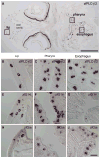Mutually exclusive expression of Gαia and Gα14 reveals diversification of taste receptor cells in zebrafish
- PMID: 21452212
- PMCID: PMC3394409
- DOI: 10.1002/cne.22589
Mutually exclusive expression of Gαia and Gα14 reveals diversification of taste receptor cells in zebrafish
Abstract
A comprehensive reevaluation of the G protein alpha subunit genes specifically expressed in taste buds in the tongue epithelium of rodents revealed that Gq and G14 of the Gq class and Gi2 and Ggust (Gt3, also known as gustducin) of the Gi class are expressed in mammalian taste buds. Meanwhile, a database search of fish genomes revealed the absence of a gene encoding an ortholog of the mammalian Ggust gene, which mediates sweet, umami, and bitter taste signals in mammalian taste receptor cells (TRCs). Histochemical screening identified two G protein alpha subunit genes, zfGia and zfG14, expressed in subsets of TRCs in zebrafish. The expression patterns of zfGia and zfG14 in taste buds were mutually exclusive, and the expression of known T1R and T2R genes in zebrafish was restricted to a subset of zfGia-expressing TRCs. These findings highlight the existence of a novel subset of TRCs in zebrafish that is absent in mammals and suggest that unidentified G protein-coupled receptors are expressed in zfG14-expressing TRCs and in zfGia-expressing TRCs where known T1R and T2R genes were not expressed in zebrafish. The existence of not only generalized but also specialized subsets of TRCs may imply a strong connection between the evolution of the peripheral gustatory system and the evolution of particular species.
Copyright © 2010 Wiley-Liss, Inc.
Figures










Similar articles
-
Expression of Galpha14 in sweet-transducing taste cells of the posterior tongue.BMC Neurosci. 2008 Nov 13;9:110. doi: 10.1186/1471-2202-9-110. BMC Neurosci. 2008. PMID: 19014514 Free PMC article.
-
Transsynaptic Tracing from Taste Receptor Cells Reveals Local Taste Receptor Gene Expression in Gustatory Ganglia and Brain.J Neurosci. 2015 Jul 1;35(26):9717-29. doi: 10.1523/JNEUROSCI.0381-15.2015. J Neurosci. 2015. PMID: 26134654 Free PMC article.
-
Shared and unique G alpha proteins in the zebrafish versus mammalian senses of taste and smell.Chem Senses. 2011 May;36(4):357-65. doi: 10.1093/chemse/bjq138. Epub 2011 Jan 17. Chem Senses. 2011. PMID: 21242316
-
Taste information derived from T1R-expressing taste cells in mice.Biochem J. 2016 Mar 1;473(5):525-36. doi: 10.1042/BJ20151015. Biochem J. 2016. PMID: 26912569 Review.
-
Elucidation of mammalian bitter taste.Rev Physiol Biochem Pharmacol. 2005;154:37-72. doi: 10.1007/s10254-005-0041-0. Rev Physiol Biochem Pharmacol. 2005. PMID: 16032395 Review.
Cited by
-
Fatty Acid Sensing in the Gastrointestinal Tract of Rainbow Trout: Different to Mammalian Model?Int J Mol Sci. 2023 Feb 21;24(5):4275. doi: 10.3390/ijms24054275. Int J Mol Sci. 2023. PMID: 36901706 Free PMC article.
-
Genetics of taste receptors.Curr Pharm Des. 2014;20(16):2669-83. doi: 10.2174/13816128113199990566. Curr Pharm Des. 2014. PMID: 23886383 Free PMC article. Review.
-
Evolutionary origins of taste buds: phylogenetic analysis of purinergic neurotransmission in epithelial chemosensors.Open Biol. 2013 Mar 6;3(3):130015. doi: 10.1098/rsob.130015. Open Biol. 2013. PMID: 23466675 Free PMC article.
-
Zebrafish and medaka T1R (taste receptor type 1) proteins mediate highly sensitive recognition of l-proline.FEBS Open Bio. 2023 Mar;13(3):468-477. doi: 10.1002/2211-5463.13558. Epub 2023 Jan 30. FEBS Open Bio. 2023. PMID: 36651084 Free PMC article.
-
CALHM3 Is Essential for Rapid Ion Channel-Mediated Purinergic Neurotransmission of GPCR-Mediated Tastes.Neuron. 2018 May 2;98(3):547-561.e10. doi: 10.1016/j.neuron.2018.03.043. Epub 2018 Apr 19. Neuron. 2018. PMID: 29681531 Free PMC article.
References
-
- Adler E, Hoon MA, Mueller KL, Chandrashekar J, Ryba NJP, Zuker CS. A novel family of mammalian taste receptors. Cell. 2000;100:693–702. - PubMed
-
- Asano-Miyoshi M, Abe K, Emori Y. Co-expression of calcium signaling components in vertebrate taste bud cells. Neurosci Lett. 2000;283:61–64. - PubMed
-
- Barlow LA, Northcutt RG. Embryonic origin of amphibian taste buds. Dev Biol. 1995;169:273–285. - PubMed
-
- Camps M, Carozzi A, Schnabel P, Scheer A, Parker PJ, Gierschik P. Isozyme-selective stimulation of phospholipase C-β2 by G protein βγ subunits. Nature. 1992;360:684–686. - PubMed
Publication types
MeSH terms
Substances
Grants and funding
LinkOut - more resources
Full Text Sources
Molecular Biology Databases

